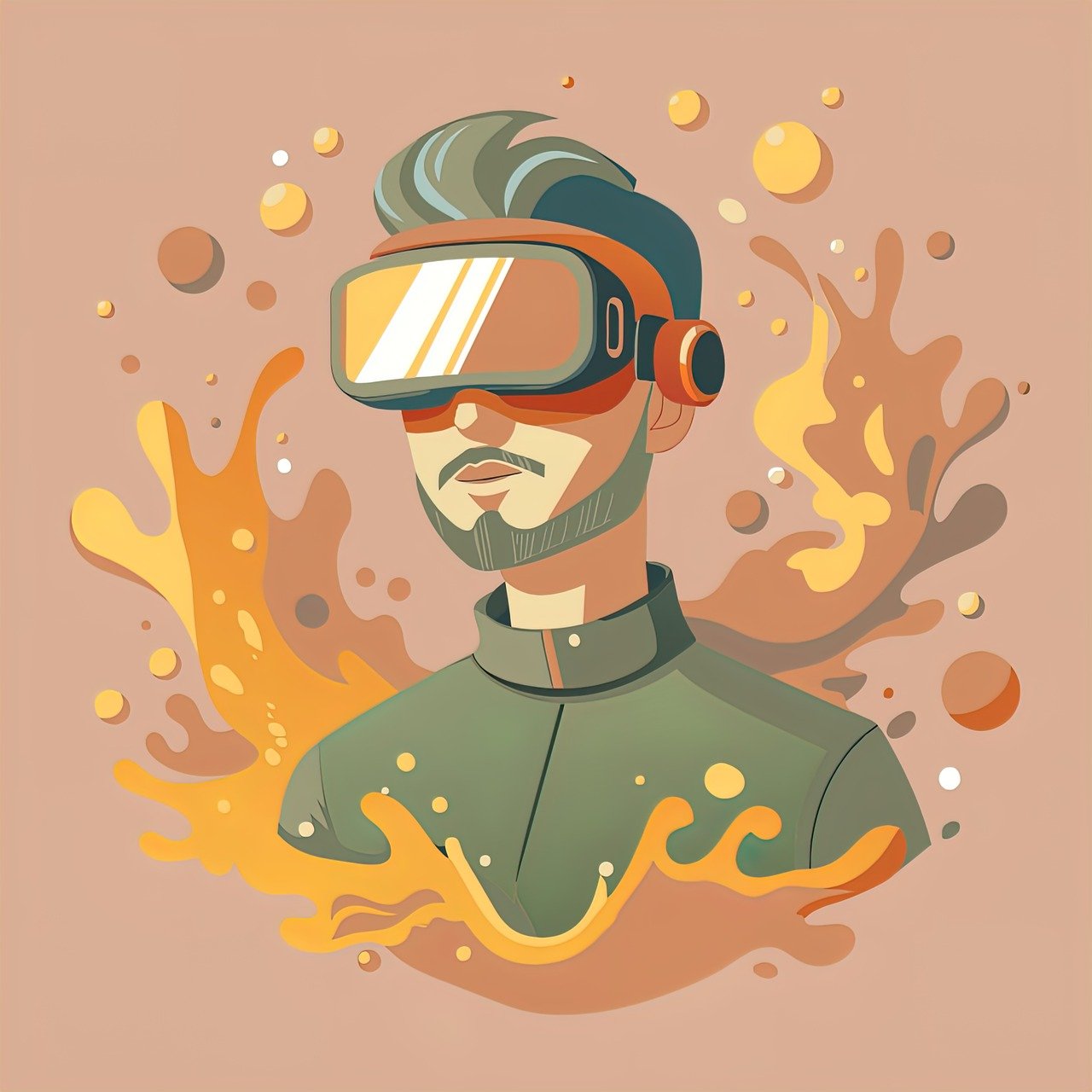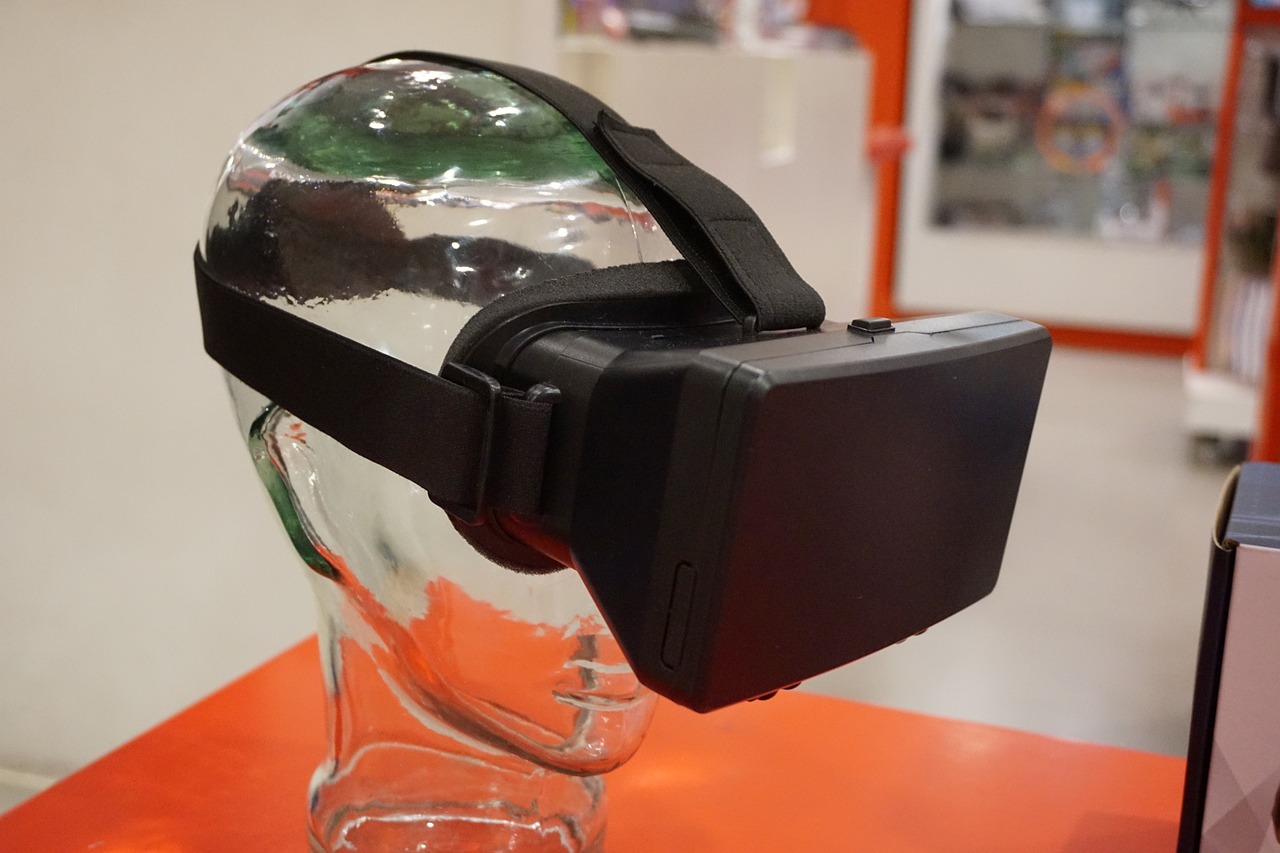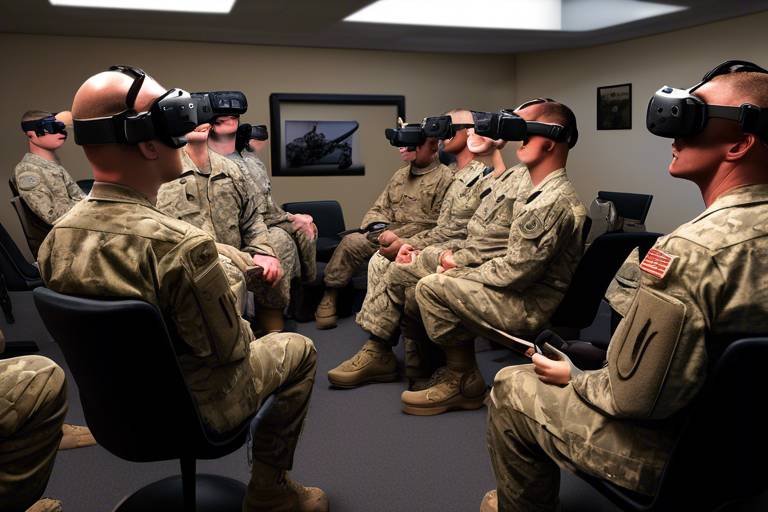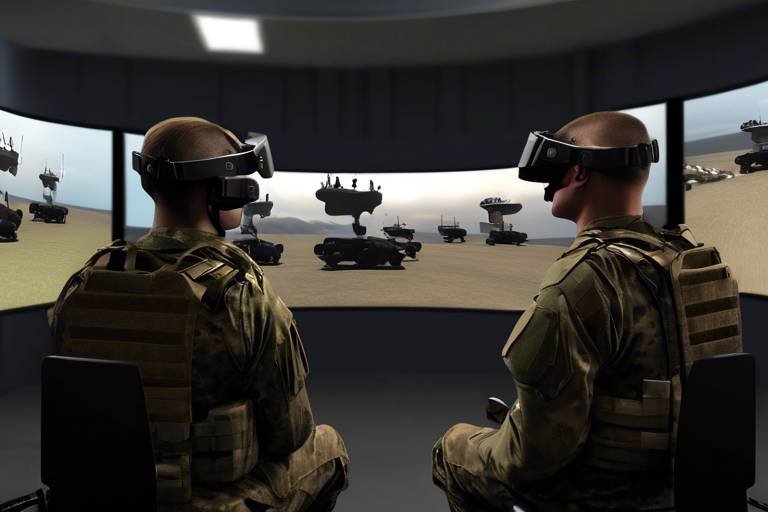The Benefits of Using VR for Environmental Adaptation Training
This article explores how virtual reality (VR) technology enhances environmental adaptation training, offering immersive experiences that improve learning, retention, and real-world application. Imagine stepping into a world where you can face environmental challenges without any real-world consequences. Sounds intriguing, right? Well, that's the magic of VR! It allows trainees to dive deep into realistic scenarios that not only boost their skills but also prepare them for real-life situations. Let's explore how this cutting-edge technology is transforming the way we train for environmental adaptation.
One of the standout features of VR is its ability to create a fully immersive environment. Picture this: instead of reading about a flood response in a textbook, you can actually experience it in a virtual setting. This level of immersion allows trainees to engage with realistic scenarios that mimic real-life challenges, enhancing their learning experience and emotional connection to the training material. Imagine feeling the rush of urgency as you navigate through a simulated disaster, making split-second decisions that could save lives. This emotional engagement not only makes the training more memorable but also instills a sense of responsibility and urgency in the trainees.
Studies show that immersive experiences in VR lead to better retention of information. When trainees practice in a simulated environment, they can recall learned skills and knowledge more effectively. It's like learning to ride a bike: you can read all the manuals in the world, but until you actually hop on and pedal, it doesn’t stick. In a similar vein, VR allows trainees to practice their skills in a way that traditional methods simply can't match. They can revisit scenarios repeatedly, reinforcing their knowledge and enhancing their ability to apply what they've learned when it truly matters.
VR enables the creation of detailed and realistic scenarios that trainees might face in their environment. For instance, if someone is training for a search and rescue operation, they can navigate through a virtual forest, encountering various obstacles and challenges. This hands-on practice provides them with the opportunity to develop and refine their responses and strategies in a safe setting. It's like being in a video game where every choice matters, but with real-world implications. The ability to rehearse these scenarios repeatedly until they become second nature is invaluable for skill development.
One of the most significant advantages of VR training is the safe learning environment it provides. In VR, learners can make mistakes without real-world consequences, promoting experimentation and learning through trial and error. This is vital for developing adaptive skills, as it encourages trainees to push their limits and explore various strategies without the fear of failure. Think of it as a safety net; you can fall as many times as you need to until you learn how to stand on your own.
Another exciting aspect of VR platforms is their ability to tailor training experiences based on specific environmental challenges. Trainers can design unique scenarios that address the unique needs and situations relevant to the trainees' future roles. This customization ensures that the training is not only relevant but also engaging. For example, if a team is preparing for a specific type of environmental disaster, the VR training can simulate that exact scenario, making the learning experience much more impactful.
The interactive nature of VR training keeps participants engaged and motivated, making the learning process enjoyable. Imagine being able to physically interact with your training environment, making choices that influence outcomes. This level of interactivity fosters a positive attitude toward skill development. When training feels more like an adventure than a chore, learners are more likely to embrace the experience and absorb the information presented to them.
Implementing VR for training can be more cost-effective in the long run. By reducing the need for physical resources and allowing for repeated training without additional costs, organizations can save money while enhancing their training programs. Think about it: instead of spending on travel, materials, and venue rentals for in-person training sessions, organizations can invest in VR technology that allows for unlimited training sessions from anywhere in the world.
With VR training, organizations can eliminate travel expenses associated with in-person sessions. This flexibility makes it easier to train employees in various locations simultaneously. Imagine a team spread across the globe, all participating in the same training session, interacting and learning together in a virtual space. It’s a game changer!
VR training solutions can easily scale to accommodate a growing workforce. As organizations expand, they can efficiently train large numbers of employees with consistent quality and content delivery. This scalability ensures that as the workforce grows, the training remains effective and accessible, providing everyone with the same high-quality learning experience.
As technology advances, the future of VR in environmental adaptation training looks promising. We can expect developments that could further enhance training effectiveness and accessibility for diverse audiences. Innovations in VR technology will likely lead to even more immersive experiences, making training not just a necessity but an exciting adventure. The horizon is bright for VR, and as we embrace these changes, the potential for improved training outcomes is limitless.
- What is VR training? VR training uses virtual reality technology to create immersive learning experiences that simulate real-world scenarios.
- How does VR improve learning? VR enhances learning by providing realistic, interactive environments that engage trainees and improve information retention.
- Is VR training cost-effective? Yes, VR training can reduce costs associated with travel, materials, and logistics while allowing for repeated training sessions.
- Can VR training be customized? Absolutely! VR platforms allow trainers to create tailored experiences based on specific environmental challenges and trainee needs.

Enhanced Immersion in Training
Imagine stepping into a world where the boundaries of reality fade away, and you find yourself in a completely immersive environment tailored to your training needs. Virtual Reality (VR) is revolutionizing how we approach training by creating experiences that are not just informative but also deeply engaging. This technology allows trainees to immerse themselves in realistic scenarios that closely mimic real-life challenges they might face in their respective fields. Whether it’s navigating through a complex emergency response or mastering intricate machinery, VR places learners in the heart of the action.
The beauty of VR lies in its ability to engage multiple senses, making the learning experience more impactful. Trainees can see, hear, and even feel their surroundings, fostering a stronger emotional connection to the material. This level of immersion is crucial because it transforms passive learning into an active experience. For instance, rather than simply reading about environmental hazards, trainees can actually experience them in a controlled setting. They can practice their responses, analyze their decisions, and learn from their mistakes in real-time.
Moreover, the emotional engagement that VR provides is unparalleled. When trainees are emotionally invested in their training, they are more likely to remember the lessons learned. Studies have shown that immersive experiences significantly enhance retention rates compared to traditional training methods. In fact, participants in VR training programs report a greater sense of presence and engagement, which translates to better recall of information when it matters most.
To illustrate the impact of VR immersion, consider a scenario where emergency responders train for a natural disaster. In a VR setting, they can experience the chaos of a flood or earthquake, complete with realistic sounds and visuals. This kind of practice not only prepares them for the physical challenges they might face but also helps them develop the mental fortitude required to handle high-pressure situations. The result? Trainees emerge more confident and capable, ready to tackle real-world challenges head-on.
In a nutshell, the enhanced immersion provided by VR training does more than just teach skills; it creates a profound learning experience that sticks with trainees long after the training session ends. As we continue to explore the possibilities of VR, it’s clear that this technology is not just a trend but a powerful tool that can reshape how we prepare individuals for the complexities of their roles in various environments.
- What is Virtual Reality (VR) training?
VR training uses simulated environments to provide immersive learning experiences that replicate real-world scenarios.
- How does VR enhance learning retention?
Immersive experiences in VR make learning more engaging, which helps trainees remember information better compared to traditional methods.
- Is VR training safe?
Yes, VR training allows learners to practice skills and make mistakes in a safe environment without real-world consequences.
- Can VR training be customized?
Absolutely! VR platforms can be tailored to meet specific training needs, addressing unique challenges relevant to the trainees' roles.

Improved Retention of Information
When it comes to learning, the ability to retain information is crucial. Imagine trying to recall a vital piece of knowledge during a high-pressure situation—it's a bit like searching for a needle in a haystack, isn't it? Thankfully, virtual reality (VR) has emerged as a game-changer in this arena. Studies have shown that immersive experiences in VR lead to significantly better retention of information compared to traditional training methods. This is because VR engages multiple senses, creating a rich tapestry of experiences that our brains are wired to remember.
One of the key reasons VR enhances retention is its ability to simulate realistic scenarios. Trainees can practice skills in environments that closely mirror real-life situations. For instance, consider a firefighter training in a VR simulation of a burning building. The sights, sounds, and even the heat sensations can create a memorable experience that sticks with them long after the training session ends. This multi-sensory approach helps encode information in our memory more effectively, making it easier to recall when needed.
Moreover, VR allows for repeated exposure to the same scenarios without the logistical hassle of real-world training. This repetition is vital for reinforcing knowledge. Just like how athletes practice their moves over and over again, VR training can provide countless opportunities for trainees to refine their skills. Each time they engage with the VR environment, they reinforce their learning and improve their muscle memory, leading to a more profound understanding of the material.
Additionally, VR training can incorporate immediate feedback mechanisms. For example, after completing a task in the VR environment, trainees can receive instant evaluations of their performance. This real-time feedback is crucial for correcting mistakes and adjusting strategies, which further solidifies their understanding. Imagine learning to navigate a complex system and receiving guidance right as you encounter a challenge; that’s the power of VR.
To illustrate the effectiveness of VR in improving retention, consider the following table that compares traditional training methods with VR training:
| Training Method | Retention Rate | Engagement Level |
|---|---|---|
| Traditional Classroom | 40% | Low |
| Hands-On Training | 60% | Medium |
| Virtual Reality Training | 80% | High |
As shown in the table, VR training boasts an impressive retention rate of 80%, significantly higher than traditional classroom methods. This stark contrast highlights how VR not only makes learning more enjoyable but also more effective. When trainees are actively engaged and immersed in their training, they are more likely to remember what they've learned and apply it in real-world situations.
In conclusion, the benefits of VR in enhancing information retention are clear. By providing immersive, realistic, and engaging training experiences, VR helps learners not only grasp concepts but also retain them long-term. So, the next time you think about training methods, remember that with VR, you're not just learning; you're stepping into a world where knowledge sticks, and skills flourish.
- How does VR training compare to traditional training methods? VR training offers a more immersive experience, leading to higher engagement and better retention of information.
- Can VR training be customized for specific needs? Yes, VR platforms allow for tailored training experiences based on the unique challenges faced by trainees.
- Is VR training cost-effective? While the initial investment can be high, VR training can save costs in the long run by reducing the need for physical resources and travel.

Realistic Scenarios for Practice
When it comes to training, nothing beats the power of realistic scenarios that closely mirror the challenges one might face in the real world. In the realm of environmental adaptation training, virtual reality (VR) excels at creating these immersive experiences that allow trainees to practice their skills in a controlled yet realistic setting. Imagine putting on a VR headset and being instantly transported to a simulated environment that feels just like the actual place you will be working in. This is not just a fantasy; it's a reality with VR technology.
These realistic scenarios are designed to replicate various environmental conditions and situations, offering trainees the chance to engage in hands-on practice. For instance, a trainee preparing for a job in disaster management might find themselves navigating through a flood, assessing the damage, and making critical decisions in real-time. The beauty of VR is that it can simulate a wide range of scenarios, including:
- Natural disasters such as hurricanes, earthquakes, and wildfires.
- Urban environments with complex logistical challenges.
- Remote areas where access to resources may be limited.
- Hazardous situations that require quick thinking and adaptability.
By immersing trainees in these realistic situations, VR training fosters a deeper understanding of the environment they will be working in. It encourages them to think critically and develop strategies that are applicable in real-life situations. Moreover, practicing in these simulated environments helps build confidence. When trainees know they can handle a variety of scenarios without any real-world repercussions, they are more likely to embrace challenges when they arise in their actual jobs.
Additionally, the feedback mechanisms integrated into VR training platforms allow trainees to receive immediate feedback on their performance. This instant evaluation is crucial for learning, as it helps identify areas for improvement and reinforces successful strategies. As a result, learners become more adept at making decisions quickly and efficiently, which is vital in high-stakes situations.
In essence, the use of realistic scenarios in VR training not only enhances the learning experience but also prepares individuals for the unpredictable nature of environmental challenges. It's like having a dress rehearsal before the big performance, where every mistake becomes a stepping stone toward mastery. As VR technology continues to evolve, the potential for even more intricate and varied scenarios is limitless, paving the way for a future where training is not just effective but also incredibly engaging.
- What are the main benefits of using VR for training? VR training offers enhanced immersion, improved retention of information, realistic practice scenarios, and a safe learning environment.
- Is VR training cost-effective? Yes, while the initial investment may be high, VR training can reduce long-term costs associated with travel and physical resources.
- Can VR training be customized? Absolutely! VR platforms allow trainers to tailor experiences based on specific challenges and needs of the trainees.
- How does VR improve engagement? The interactive nature of VR keeps participants motivated and makes learning enjoyable, leading to a positive attitude towards skill development.

Safe Learning Environment
One of the most significant advantages of using Virtual Reality (VR) for environmental adaptation training is the creation of a . Imagine stepping into a world where you can explore complex scenarios without the fear of real-world repercussions. This is precisely what VR offers—an opportunity to practice skills in a controlled setting where mistakes are not only acceptable but encouraged. In traditional training environments, the fear of failure can often stifle creativity and hinder learning. However, in a VR setting, learners can experiment freely, testing their responses to various situations without the anxiety of negative consequences.
In this virtual realm, trainees can face challenges that mirror real-life situations, such as navigating through a natural disaster or managing a crisis in a corporate setting. The beauty of VR lies in its ability to simulate these experiences realistically. For instance, a firefighter trainee can practice battling flames in a virtual building, allowing them to hone their skills without the danger of actual fire. This kind of immersive training not only builds confidence but also fosters a deeper understanding of the skills required to adapt to environmental challenges.
Moreover, the safe learning environment provided by VR promotes trial and error, which is crucial for developing adaptive skills. When learners know they can fail and try again, they are more likely to push their limits and explore innovative solutions. This process of exploration is vital in fields where quick decision-making and adaptability are essential. By making mistakes in a virtual space, trainees can reflect on their actions, analyze what went wrong, and learn from their experiences without the pressure of real-world stakes.
Additionally, VR training can be customized to address specific scenarios that trainees may encounter in their future roles. For example, a medical professional can practice surgical procedures in a VR environment, allowing them to refine their techniques and decision-making processes in a safe space before they ever step into an operating room. This tailored approach ensures that learners are not only prepared but also confident when facing real-life challenges.
In conclusion, the safe learning environment that VR provides is a game-changer in training methodologies. It empowers learners to engage deeply with the material, promotes a culture of experimentation, and ultimately leads to better preparation for the unpredictable nature of real-world environments.
- What is VR training? VR training uses virtual reality technology to create immersive learning experiences that simulate real-world scenarios.
- How does VR improve learning? VR enhances learning by providing realistic simulations, allowing for better engagement, retention, and application of skills in real-life situations.
- Is VR training safe? Yes, VR training offers a safe environment where learners can make mistakes and learn from them without real-world consequences.
- Can VR training be customized? Absolutely! VR platforms can be tailored to meet specific training needs and scenarios relevant to the learners' future roles.
- What are the cost benefits of VR training? VR training can reduce travel and logistics costs while allowing organizations to train large numbers of employees efficiently.

Customizable Training Experiences
One of the standout features of virtual reality (VR) training is its ability to offer tailored to the unique needs of each trainee or organization. Imagine being able to create a specific environment that mirrors the exact conditions your team will face in the field. This level of customization not only enhances the relevance of the training but also ensures that learners are better prepared for the challenges ahead.
With VR, trainers can design scenarios that reflect real-world challenges, from environmental hazards to emergency situations, allowing trainees to practice their responses in a controlled yet realistic setting. For instance, if a team is preparing for a disaster response, VR can simulate various scenarios such as floods, earthquakes, or wildfires, enabling them to strategize and rehearse their actions without the risks associated with real-life training.
Furthermore, the adaptability of VR platforms means that training can be adjusted on-the-fly. If a particular scenario isn’t resonating with trainees or if they require additional focus on specific skills, trainers can tweak the experience instantly. This adaptability is crucial in today’s fast-paced world, where the ability to respond to new information and evolving challenges is key to success.
Additionally, VR training can cater to different learning styles. Some individuals may thrive in visual environments, while others might benefit from auditory or kinesthetic learning. By incorporating various elements—such as visual cues, sound effects, and hands-on simulations—VR can engage all types of learners, making the training experience not only more effective but also more enjoyable.
In essence, the customizable nature of VR training allows organizations to create a tailored learning journey for each trainee, ensuring that the skills they acquire are directly applicable to their future roles. This personalized approach significantly boosts the overall effectiveness of the training, leading to improved performance in real-world situations.
- What is VR training? VR training uses virtual reality technology to create immersive learning environments where trainees can practice skills and scenarios safely.
- How does VR enhance learning? VR enhances learning by providing realistic simulations that improve engagement, retention, and the ability to apply skills in real-life situations.
- Is VR training cost-effective? Yes, VR training can reduce costs by minimizing travel expenses and resource needs, while allowing for repeated training without additional costs.
- Can VR training be customized? Absolutely! VR training experiences can be tailored to meet the specific needs and challenges of different organizations and trainees.
- What are the future trends in VR training? Future trends include advancements in technology that will further enhance the effectiveness and accessibility of VR training for various audiences.

Increased Engagement and Motivation
When it comes to training, one of the biggest challenges is keeping participants engaged and motivated. Traditional methods often fall flat, leaving trainees feeling disconnected and uninspired. Enter Virtual Reality (VR), a game-changer that transforms the training landscape. With VR, learners are not just passive receivers of information; they become active participants in their own learning journey. Imagine stepping into a virtual world where you can interact with your environment, make decisions, and see the consequences of those decisions in real time. This level of immersion captivates the learner's attention, making them more likely to absorb and retain information.
The interactive nature of VR training creates a sense of ownership over the learning process. Trainees can experiment with different strategies and approaches without the fear of real-world repercussions. This freedom to explore fosters a deeper emotional connection to the material, as they are not just memorizing facts but are actively applying their knowledge in a simulated environment. Moreover, the thrill of using cutting-edge technology adds an element of excitement that is often missing in conventional training methods.
Consider the impact of gamification in VR training. By incorporating game-like elements such as points, levels, and challenges, trainers can significantly boost motivation. Participants are driven to complete tasks and improve their scores, creating a friendly competitive atmosphere. This not only makes learning fun but also encourages collaboration among trainees as they work together to overcome challenges. The result? A more dynamic, engaging, and enjoyable training experience that keeps learners coming back for more.
Additionally, the flexibility of VR allows for personalized learning experiences. Trainees can progress at their own pace, revisiting challenging scenarios as needed. This adaptability caters to different learning styles, ensuring that everyone can engage with the material in a way that resonates with them. Whether someone thrives on visual stimuli or learns best through hands-on experiences, VR can accommodate those needs, making the training process more effective.
In conclusion, the ability of VR to foster is a powerful advantage in environmental adaptation training. By creating an interactive, immersive, and personalized learning experience, VR not only enhances knowledge retention but also cultivates a positive attitude towards skill development. As we continue to explore the potential of this technology, one thing is clear: the future of training is not just about learning; it's about experiencing.
- What is VR training?
VR training uses virtual reality technology to create immersive learning experiences that simulate real-world scenarios. - How does VR improve engagement?
The interactive nature of VR allows learners to actively participate, making the training process more enjoyable and motivating. - Is VR training cost-effective?
Yes, VR training can reduce costs associated with travel and physical resources, making it a long-term investment for organizations. - Can VR training be customized?
Absolutely! VR platforms allow trainers to tailor experiences based on specific needs and scenarios relevant to the trainees.

Cost-Effectiveness of VR Training
When it comes to training, organizations are constantly on the lookout for methods that not only enhance learning but also keep costs in check. Enter Virtual Reality (VR) training—a game-changer that brings a host of financial benefits to the table. One of the most compelling aspects of VR training is its ability to significantly reduce costs associated with traditional training methods. Imagine the savings when you can eliminate the need for physical training spaces, travel expenses, and materials that often pile up during in-person sessions. With VR, all you need is a headset and a computer, and you’re ready to dive into immersive training experiences without the hefty price tag.
Moreover, VR training allows for repeated practice without incurring additional costs. In traditional settings, running a training session multiple times can be resource-intensive. But with VR, organizations can simply replay the training modules as often as necessary. This flexibility not only enhances learning but also ensures that employees are consistently up-to-date with the latest skills and knowledge. To illustrate this point, consider the following table that compares the costs of traditional training versus VR training:
| Training Method | Initial Setup Cost | Ongoing Costs | Scalability |
|---|---|---|---|
| Traditional Training | High (venue, materials) | Medium (refreshers, updates) | Limited (space and resources) |
| VR Training | Moderate (hardware, software) | Low (updates are digital) | High (easily scalable) |
This table clearly shows that while the initial investment in VR technology might be moderate, the ongoing costs are significantly lower compared to traditional methods. Plus, the scalability of VR means that as your workforce grows, your training can effortlessly expand to meet demand without the need for additional resources. This is particularly vital for organizations that are rapidly evolving or hiring new talent.
Another noteworthy advantage of VR training is the elimination of travel and logistics costs. Traditional training often requires employees to travel to a specific location, which can be both time-consuming and expensive. With VR, training can occur anywhere, at any time, allowing organizations to train employees in different locations simultaneously. This not only saves money but also maximizes productivity, as employees can engage in training sessions without the need for extensive travel arrangements.
In summary, the cost-effectiveness of VR training is clear. From reducing initial and ongoing costs to eliminating travel expenses and enhancing scalability, VR presents a compelling case for organizations looking to optimize their training programs. By investing in this technology, companies can not only save money but also provide their employees with a training experience that is both engaging and effective.

Reduced Travel and Logistics Costs
One of the most significant advantages of implementing Virtual Reality (VR) in environmental adaptation training is the substantial reduction in travel and logistics costs. Traditional training often requires participants to travel to specific locations, which can lead to hefty expenses that include airfare, accommodation, meals, and transportation. These costs can quickly add up, especially for organizations with a large workforce or multiple locations. In contrast, VR training allows employees to engage in realistic simulations from the comfort of their own offices or homes, effectively eliminating the need for travel.
Imagine a scenario where a company needs to train its staff on safety protocols for hazardous environments. Instead of flying everyone to a training facility, which can be both time-consuming and costly, they can simply provide VR headsets and software that simulate the training environment. This not only saves money but also time, as employees can complete their training sessions at their convenience without the added stress of travel logistics.
Furthermore, the flexibility of VR training means that organizations can conduct sessions simultaneously across different locations. This is particularly beneficial for multinational companies that may have employees scattered across various countries. With VR, a single training module can be delivered to hundreds of employees at once, regardless of where they are located. This scalability not only enhances efficiency but also ensures that all employees receive the same high-quality training experience.
To illustrate the cost benefits, consider the following comparison:
| Training Method | Cost Factors | Total Estimated Cost |
|---|---|---|
| Traditional Training |
|
$5,000 - $10,000 |
| VR Training |
|
$1,000 - $3,000 |
As shown in the table, the cost of traditional training can be significantly higher than that of VR training. This cost-effectiveness not only benefits the organization's bottom line but also allows for reallocating funds towards further training development, enhancing the overall training program.
In summary, the reduced travel and logistics costs associated with VR training make it an attractive option for organizations looking to optimize their training processes. By eliminating the need for physical travel, companies can save money, improve employee satisfaction, and ensure that training is accessible to everyone, regardless of their location.
Q: How does VR training reduce travel costs?
A: VR training eliminates the need for employees to travel to training facilities, significantly cutting down on expenses related to airfare, accommodation, and meals.
Q: Can VR training be scaled for large organizations?
A: Yes! VR training can easily accommodate a growing workforce and can deliver consistent training experiences to multiple employees at once, regardless of their location.
Q: What are the long-term financial benefits of using VR for training?
A: In the long run, VR training can reduce overall training costs, minimize logistical challenges, and allow for repeated training sessions without additional expenses.

Scalability for Organizations
One of the most remarkable advantages of utilizing Virtual Reality (VR) in environmental adaptation training is its scalability. As organizations expand, the need for efficient and effective training solutions becomes increasingly critical. VR training systems can be designed to accommodate a growing workforce with ease. Imagine a scenario where a company is onboarding a large number of employees at once; traditional training methods can become cumbersome and resource-intensive. However, with VR, the same high-quality training can be delivered to hundreds, or even thousands, of trainees simultaneously, all while maintaining consistency in the content and quality of the training experience.
Furthermore, VR platforms allow organizations to update training modules quickly and efficiently. When new environmental challenges or procedures arise, companies can simply modify their VR training programs without the need for extensive retraining sessions or additional logistical planning. This adaptability not only saves time and resources but also ensures that employees are always equipped with the most current information and skills they need to thrive in their roles.
In addition to being cost-effective, the scalability of VR training promotes a culture of continuous learning. Employees can revisit training modules at their convenience, reinforcing their skills and knowledge as they progress in their careers. This flexibility is crucial in today’s fast-paced work environment, where staying ahead of the curve is essential for success. Organizations can track progress and performance through built-in analytics, allowing for personalized training paths that cater to individual strengths and weaknesses.
To illustrate the benefits of scalability in VR training, consider the following table:
| Aspect | Traditional Training | VR Training |
|---|---|---|
| Employee Onboarding | Time-consuming and resource-heavy | Efficient and simultaneous for many |
| Content Updates | Requires extensive planning and retraining | Quick updates with minimal disruption |
| Accessibility | Location-dependent | Accessible from anywhere with VR equipment |
| Engagement | Passive learning experience | Interactive and immersive |
In summary, the scalability of VR training solutions not only enhances the training experience but also aligns with the strategic goals of organizations looking to grow and adapt in a constantly changing environment. By investing in VR technology, companies can ensure that their workforce is well-prepared and equipped to handle the challenges of tomorrow.
- What is VR training? VR training utilizes virtual reality technology to create immersive learning experiences that simulate real-world scenarios.
- How does VR improve retention of information? The immersive nature of VR engages multiple senses, enhancing memory retention and recall of learned skills.
- Is VR training cost-effective? Yes, while the initial investment may be high, VR training can reduce long-term costs related to travel, materials, and time.
- Can VR training be customized? Absolutely! VR platforms allow for tailored experiences to meet the specific needs of different trainees and scenarios.
- What industries can benefit from VR training? Industries such as healthcare, construction, emergency services, and corporate training can all leverage VR for effective training solutions.

Future Trends in VR Training
The landscape of virtual reality (VR) training is evolving at a rapid pace. As technology advances, we are witnessing a transformation in how training is conducted, particularly in the realm of environmental adaptation. The future holds exciting possibilities that promise to make VR training even more effective and accessible. Imagine a world where trainees can experience simulated environments that are not only realistic but also adaptive to their learning needs. This is not just a dream—it's becoming a reality!
One of the most significant trends we can anticipate is the integration of artificial intelligence (AI) with VR. This combination will allow for the creation of personalized training experiences. AI can analyze a trainee's performance in real-time and adjust scenarios accordingly, ensuring that each individual receives the most relevant training. For instance, if a trainee struggles with a particular challenge, the AI can modify the environment to provide additional support or alternative scenarios that target those weaknesses.
Moreover, the rise of augmented reality (AR) in conjunction with VR is another trend to watch. Imagine wearing AR glasses that overlay digital information onto your real-world environment while simultaneously engaging in a VR training module. This hybrid approach can enhance the learning experience by providing contextual information, making it easier for trainees to apply what they learn in real-world situations. It’s like having a mentor by your side, guiding you through complex tasks and providing instant feedback!
Additionally, we are likely to see an increase in the use of social VR platforms. These platforms allow multiple users to interact in a shared virtual space, creating opportunities for collaborative training. Trainees can work together to solve problems, share insights, and learn from each other in a way that mirrors real-life teamwork. This social aspect not only enhances engagement but also fosters a sense of community among trainees, making the learning experience more enjoyable and impactful.
As VR technology becomes more affordable, we can expect wider adoption across various industries. This democratization of VR training means that even small businesses will have access to high-quality training solutions. The ability to train employees effectively without the need for extensive physical resources will empower organizations of all sizes to invest in their workforce's development.
Finally, the potential for gamification in VR training cannot be overlooked. By incorporating game-like elements, such as rewards, challenges, and leaderboards, training can become more engaging and motivating. Gamification taps into our natural desire for competition and achievement, making the learning process not just educational but also fun. This approach can lead to higher retention rates and better overall performance.
In conclusion, the future of VR training for environmental adaptation is bright and full of promise. With advancements in AI, the rise of AR, the growth of social VR platforms, increased accessibility, and the incorporation of gamification, we are on the brink of a training revolution. As these trends continue to develop, we can expect VR training to play an even more critical role in preparing individuals for real-world challenges.
- What is VR training? VR training uses virtual reality technology to create immersive learning experiences that simulate real-world scenarios.
- How does VR training improve learning? VR training enhances learning by providing interactive and engaging experiences that improve information retention and application.
- Can VR training be customized? Yes, VR training can be tailored to meet specific needs and challenges relevant to the trainees' roles.
- Is VR training cost-effective? Over time, VR training can reduce costs associated with physical resources and travel, making it a cost-effective solution.
- What are the future trends in VR training? Future trends include AI integration, augmented reality, social VR platforms, increased accessibility, and gamification.
Frequently Asked Questions
- What is VR environmental adaptation training?
VR environmental adaptation training utilizes virtual reality technology to create immersive learning experiences that help individuals adapt to various environmental challenges. This training allows participants to engage with realistic scenarios, enhancing their understanding and skills in a safe setting.
- How does VR improve retention of information?
Studies have shown that immersive experiences, like those provided by VR, significantly enhance information retention. When trainees practice skills in a simulated environment, they are more likely to recall what they learned, as the emotional and contextual engagement helps solidify their knowledge.
- Can VR training be customized for different needs?
Absolutely! One of the standout features of VR training is its ability to be tailored to meet specific environmental challenges. Trainers can design unique scenarios that address the particular needs of their trainees, ensuring that the training is relevant and impactful.
- Is VR training safe for learners?
Yes, VR training provides a safe learning environment where participants can make mistakes without facing real-world consequences. This aspect encourages experimentation and allows learners to develop adaptive skills through trial and error, which is crucial for effective training.
- What are the cost benefits of VR training?
Implementing VR training can be more cost-effective over time. It reduces the need for physical resources, cuts down on travel expenses, and allows organizations to conduct repeated training sessions without incurring additional costs, making it a smart investment.
- How scalable is VR training for organizations?
VR training solutions are highly scalable, meaning they can easily adapt to accommodate a growing workforce. Organizations can efficiently train large numbers of employees with consistent quality and content delivery, regardless of their geographical locations.
- What future trends can we expect in VR training?
The future of VR in environmental adaptation training looks bright! With ongoing advancements in technology, we can expect developments that will further enhance the effectiveness and accessibility of training for diverse audiences, making it an exciting area to watch.



















